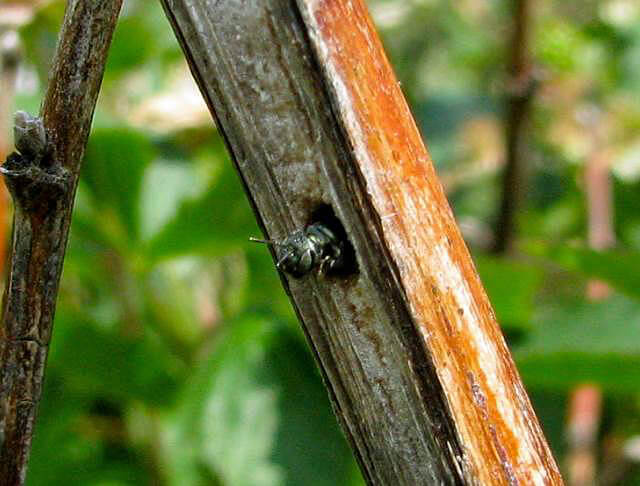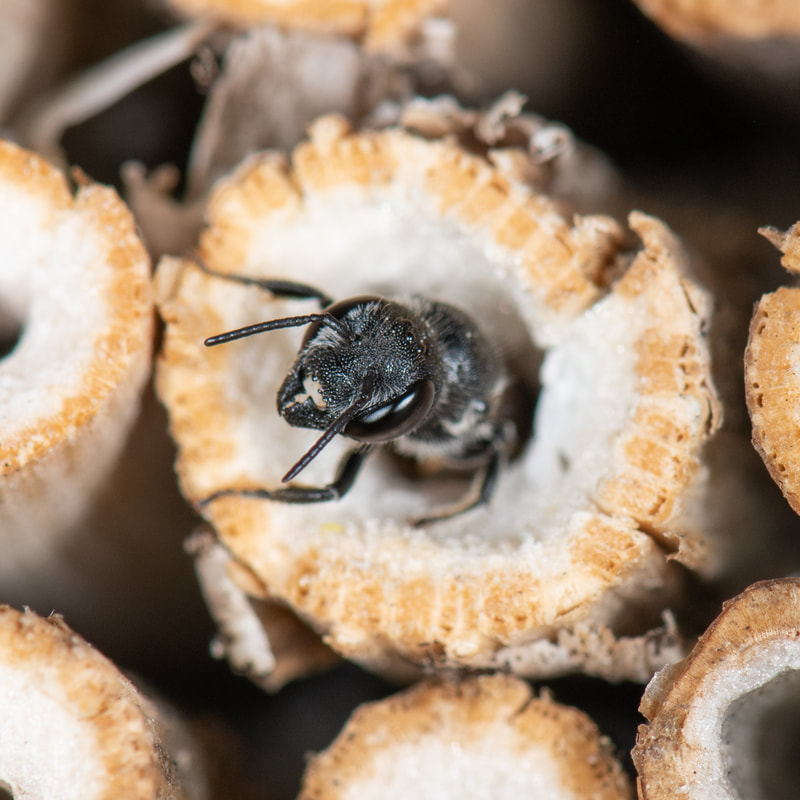By Jenifer Heath
Honey bees are native to Europe and were imported to the U.S. There are over 900 different bee species that are native to Colorado. About 30 percent of our native bee species nest in stems. Most are not yellow and black and only 12 percent of species are social; the rest are solitary. According to CBS News Colorado, our native bee population has decreased by 72 percent over the last 25 years. This article is intended to share information that will help us support our stem-nesting bees.

How quickly science provides new information meant to inform or influence our behavior! It seems it was just a few years ago that I learned to curb my yard cleanup practices at the end of the growing season. In support of the ecosystem and habitat, I do not do fall yard cleanup – no cutting down of autumn stems for me! We leave the stems up so native birds can dine on the seeds of those plants through late fall and winter, and so bees and other invertebrates can nest and shelter in the stems. I also leave the leaves, in which many adult and larval insects and other invertebrates overwinter. And this year I started moving “extra” leaves into piles under trees to enrich the soil, provide winter shelter for invertebrates, and contribute to a soft landing for insect life stages that may leave the trees to shelter in the leaves below.
With the approach of spring, I’ve been thinking of spring cleanup. The guideline used to be something like: “don’t cut down hollow/pithy stems until the outdoor temperature is consistently over ‘x’ degrees.” But now we know that is not an optimal guideline. Creatures are not overwintering this winter in the hollow/pithy stems that bloomed this past season; rather it is a three-year cycle.
First, evidently insects don’t nest or shelter in living stems of plants. So there may be no insects, eggs, larva or adults, in the stems that first winter. Second, because bees of different species have very different lifespans and seasons, they build their nests and provision cells for their offspring at different times of year. Some bees will be provisioning hollow/pithy stems very early in the spring, but others won’t even emerge as adults until fall and it will be late fall by the time they are provisioning cells or providing nesting for their offspring. If we cut down stems each Spring, we are eliminating the next generation of native stem-nesting bees. Read on for the solution!
The Three Year Approach
- Year 1: This is the year that the stems are alive and supporting blossoms and seeds.
- Late Winter Year 1: Remove the seed heads from the top of hollow/pithy stems, leaving an 8- to 20-inch stem standing. Sharp cutting tools are recommended for this task, simply because that leaves behind a neat stem top that is easier for the insect to seal off to protect her next generation.
- Early Spring Year 2 (when we used to remove the hollow/pithy stems): Simply trim off the seed heads, leaving the hollow/pithy stems at a height of 8 to 20 inches.
- Throughout Spring, Summer and Fall Year 2: Female insects are provisioning cells and laying eggs in the dead hollow/pithy stems.
- Winter Year 2: All appears quiet for these stems, but the next generation is developing and waiting for their moment to emerge.
- Starting Spring Year 3 through Fall Year 3: The next generations of the various species emerge, each in their own season.
See also “How to Create Habitat for Stem-nesting Bees” in the resource section below.
In other words, to play their full role as habitat and to support development of the next generation (and in the bigger picture, the survival of above-ground nesting bees and perhaps others), hollow/pithy stems must remain in place for 3 years. If we remove them too early, they will have had no nests in them (Winter Year 1) or we will be destroying and discarding (or composting) all the nests, eggs, larva, the entire next generation.



Photos courtesy of www.pollinatorsnativeplants.com
Speaking for myself, it’s hard to imagine or think about what my yard will be like with that many old stems that will not be cut down. Stems will be in my yard the first year when they have flowers on top and the entire second year while bees and other insects are laying eggs for the next generation and provisioning nests in those hollow/pithy stems, and then the third year when the stems need to be there for that next generation to emerge. It’s hard to contemplate.
This late winter/spring (Winter Year 1, Spring Year 2), my plan is to remove the seed heads from the top of hollow/pithy stems, leaving the hollow/pithy stems at heights of 8 to 20 inches. I have read that both large/wide and small/narrow stems may be hollow/pithy, with different sizes appropriate for different bee species, so I will not discriminate based on width. But I’m only going to leave the hollow/pithy stems (not nearly all of the stems in my yard). To simplify my task and focus on leaving in place the “right” stems, I’ve done a bit of research as to which genuses (the plant classification level above species or the first name in the scientific name of a plant) have hollow/pithy stems and which ones are native in my area. Below is a list that I have put together based on several sources.
A few other things I’ve learned: (1) it will not work to cut down the stems and pile them somewhere else, and (2) it will not work to cut down the stems and somehow cage them so that they’re standing somewhere else. Ecologically that would not be the same as a stem in place in the yard.
I hope that in two or three years many of us will be talking about what happened when we did not cut down hollow/pithy stems for 3 years. Will our neighbors even notice? Did anyone complain? Were they open to the reasons to leave hollow/pithy stems in place? Will an increase in insect numbers and diversity be evident in our yards or neighborhoods? Did you find certain plant species to be used for nesting more heavily? Not at all?
Resources related to stem cleanup:
Tufts Pollinator Initiative (“The right way to leave stems for native bees”) – I highly recommend reading this brief piece. The point is that it’s not just about waiting until spring to do garden cleanup (i.e. cut down old stems) – rather it’s a multi-year process for stems to live, then later host insects or eggs until they emerge. There is a lot of additional information in the comment/response following the main article.
My (preliminary) list of hollow/pithy stem plants – stems in which insects may nest, overwinter, and lay eggs (leaving these stems standing for 3 years is important if we want the next generations of the insects that use them): Solidago rigida or speciosa (goldenrod), Ratibida pinnata (or maybe columnifera), Echinacea pallida (and maybe angustifolia or purpurea), Symphyotrichum (asters), Silphium (like cup plants, rosinweed), Helianthus (sunflowers), Eutrochium (joe pye weed), Panicum virgatum (switchgrass), Sorghastrum nutans (Indian grass), Sporobolus heterolepsis (prairies drop seed), Schizachyrium scoparium (little bluestem), Andropogan geradii (big blustem), Rubus spp (raspberries), Monarda (bee balm). I suspect that other species in these genuses may also have hollow/pithy stems (reminder: Domain, Kingdom, Phylum, Class, Order, Family, Genus, Species, [Variety])
5 Ways to Increase Nesting Habitat for Native Bees
Flower Stalks for Bees Nests
Bird-Friendly Winter Gardens
Curious to learn more about transforming your garden into a habitat with Colorado native wildflowers, grasses, shrubs, and trees? Check out our native gardening toolkit, register for an upcoming event, subscribe to our newsletter, and/or become a member – if you’re not one already!
